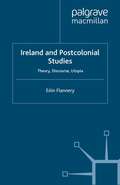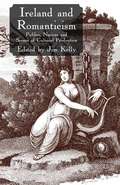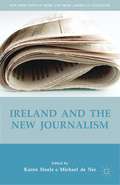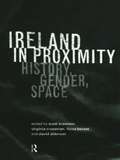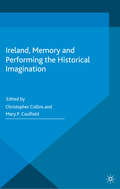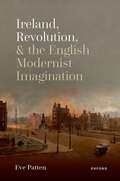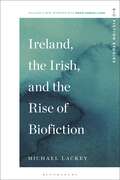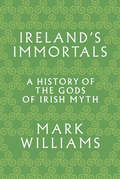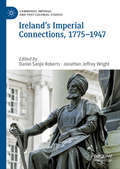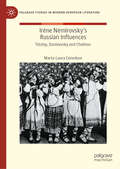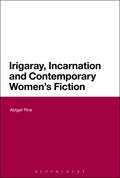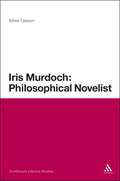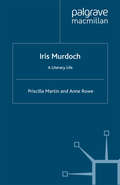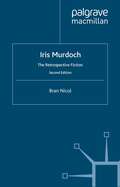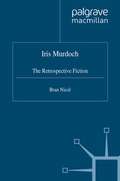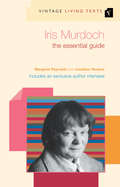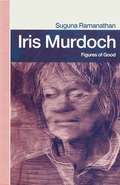- Table View
- List View
Ireland and Postcolonial Studies: Theory, Discourse, Utopia
by Eóin FlanneryA pioneering study of the development of one of the key critical discourses in contemporary Irish studies, this book covers all the major figures, publications and debates within Irish postcolonial criticism, delivering a commentary on this diverse body of work as well as positioning Irish postcolonial criticism within the wider postcolonial field.
Ireland and Romanticism: Publics, Nations and Scenes of Cultural Production
by Jim KellyThis collection by leading scholars in the field provides a fascinating and ground-breaking introduction to current research in Irish Romantic studies. It proves the international scope and aesthetic appeal of Irish writing in this period, and shows the importance of Ireland to wider currents in Romanticism.
Ireland and the New Journalism (New Directions in Irish and Irish American Literature)
by Karen Steele Michael De NieThis volume explores the ways in which the complicated revolution in British newspapers, the New Journalism, influenced Irish politics, culture, and newspaper practices. The essays here further illuminate the central role of the press in the evolution of Irish nationalism and modernism in the late nineteenth and early twentieth centuries.
Ireland in Proximity: History, Gender and Space
by David Alderson Fiona Becket Scott Brewster Virginia CrossmanIreland in Proximity surveys and develops the expanding field of Irish Studies, reviewing existing debates within the discipline and providing new avenues for exploration. Drawing on a variety of disciplinary and theoretical approaches, this impressive collection of essays makes an innovative contribution to three areas of current, and often contentious, debate within Irish Studies. This accessible volume illustrates the diversity of thinking on Irish history, culture and identity. By invoking theoretical perspectives including psychoanalysis, cultural theories of space, postcoloniality and theories of gender and sexual difference, the collection offers fresh perspectives on established subjects and brings new and under-represented areas of critical concern to the fore. Chapter subjects include: * sexuality and gender identities * the historiographical issues surrounding the Famine * the Irish diaspora * theories of space in relation to Ulster and beyond. Contributors inlcude: David Alderson, Aidan Arrowsmith, Caitriona Beaumont, Fiona Becket, Scott Brewster, Dan Baron Cohen, Mary Corcoran, Virginia Crossman, Richard Kirkland, David Lloyd, Patrick McNally, Elisabeth Mahoney, Willy Maley, Shaun Richards, Éibhear Walshe.
Ireland in Proximity: History, Gender and Space
by Scott Brewster Virginia Crossman Fiona Becket David AldersonIreland in Proximity surveys and develops the expanding field of Irish Studies, reviewing existing debates within the discipline and providing new avenues for exploration. Drawing on a variety of disciplinary and theoretical approaches, this impressive collection of essays makes an innovative contribution to three areas of current, and often contentious, debate within Irish Studies. This accessible volume illustrates the diversity of thinking on Irish history, culture and identity. By invoking theoretical perspectives including psychoanalysis, cultural theories of space, postcoloniality and theories of gender and sexual difference, the collection offers fresh perspectives on established subjects and brings new and under-represented areas of critical concern to the fore. Chapter subjects include: * sexuality and gender identities * the historiographical issues surrounding the Famine * the Irish diaspora * theories of space in relation to Ulster and beyond. Contributors inlcude: David Alderson, Aidan Arrowsmith, Caitriona Beaumont, Fiona Becket, Scott Brewster, Dan Baron Cohen, Mary Corcoran, Virginia Crossman, Richard Kirkland, David Lloyd, Patrick McNally, Elisabeth Mahoney, Willy Maley, Shaun Richards, Éibhear Walshe.
Ireland, Literature, and the Coast: Seatangled
by Nicholas AllenThe island of Ireland is home to one of the world's great literary and artistic traditions. This book reads Irish literature and art in context of the island's coastal and maritime cultures, beginning with the late imperial experiences of Jack and William Butler Yeats and ending with the contemporary work of Anne Enright and Sinead Morrissey. It includes chapters on key historical texts such as Erskine Childers's The Riddle of the Sands, and on contemporary writers including Eiléan Ní Chuilleanáin and Kevin Barry. It sets a diverse range of writing and visual art in a fluid panorama of liquid associations that connect Irish literature to an archipelago of other times and places. Situated within contemporary conversations about the blue and the environmental humanities, this book builds on the upsurge of interest in seas and coasts in literary studies, presenting James Joyce, Elizabeth Bowen, John Banville, and many others in new coastal and maritime contexts. In doing so, it creates a literary and visual narrative of Irish coastal cultures across a seaboard that extends to a planetary configuration of imagined islands.
Ireland, Literature, and the Coast: Seatangled
by Nicholas AllenThe island of Ireland is home to one of the world's great literary and artistic traditions. This book reads Irish literature and art in context of the island's coastal and maritime cultures, beginning with the late imperial experiences of Jack and William Butler Yeats and ending with the contemporary work of Anne Enright and Sinead Morrissey. It includes chapters on key historical texts such as Erskine Childers's The Riddle of the Sands, and on contemporary writers including Eiléan Ní Chuilleanáin and Kevin Barry. It sets a diverse range of writing and visual art in a fluid panorama of liquid associations that connect Irish literature to an archipelago of other times and places. Situated within contemporary conversations about the blue and the environmental humanities, this book builds on the upsurge of interest in seas and coasts in literary studies, presenting James Joyce, Elizabeth Bowen, John Banville, and many others in new coastal and maritime contexts. In doing so, it creates a literary and visual narrative of Irish coastal cultures across a seaboard that extends to a planetary configuration of imagined islands.
Ireland, Memory and Performing the Historical Imagination
by Mary P. CaulfieldThis book explores the performance of Irish collective memories and forgotten histories. It proposes an alternative and more comprehensive criterion of Irish theatre practices. These practices can be defined as the 'rejected', contested and undervalued plays and performativities that are integral to Ireland's political and cultural landscapes.
Ireland, Revolution, and the English Modernist Imagination
by Eve PattenThis book asks how English authors of the early to mid twentieth-century responded to the nationalist revolution in neighbouring Ireland in their work, and explores this response as an expression of anxieties about, and aspirations within, England itself. Drawing predominantly on novels of this period, but also on letters, travelogues, literary criticism, and memoir, it illustrates how Irish affairs provided a marginal but pervasive point of reference for a wide range of canonical authors in England, including Wyndham Lewis, Virginia Woolf, D.H. Lawrence, Graham Greene, and Evelyn Waugh, and also for many lesser-known figures such as Ethel Mannin, George Thomson, and T.H. White. The book surveys these and other incidental writers within the broad framework of literary modernism, an arc seen to run in temporal parallel to Ireland's revolutionary trajectory from rebellion to independence. In this context, it addresses two distinct aspects of the Irish-English relationship as it features in the literature of the time: first, the uneasy recognition of a fundamental similarity between the two countries in terms of their potential for violent revolutionary instability, and second, the proleptic engagement of Irish events to prefigure, imaginatively, the potential course of England's evolution from the Armistice to the Second World War. Tracing these effects, this book offers a topical renegotiation of the connections between Irish and English literary culture, nationalism, and political ideology, together with a new perspective on the Irish sources engaged by English literary modernism.
Ireland, Revolution, and the English Modernist Imagination
by Eve PattenThis book asks how English authors of the early to mid twentieth-century responded to the nationalist revolution in neighbouring Ireland in their work, and explores this response as an expression of anxieties about, and aspirations within, England itself. Drawing predominantly on novels of this period, but also on letters, travelogues, literary criticism, and memoir, it illustrates how Irish affairs provided a marginal but pervasive point of reference for a wide range of canonical authors in England, including Wyndham Lewis, Virginia Woolf, D.H. Lawrence, Graham Greene, and Evelyn Waugh, and also for many lesser-known figures such as Ethel Mannin, George Thomson, and T.H. White. The book surveys these and other incidental writers within the broad framework of literary modernism, an arc seen to run in temporal parallel to Ireland's revolutionary trajectory from rebellion to independence. In this context, it addresses two distinct aspects of the Irish-English relationship as it features in the literature of the time: first, the uneasy recognition of a fundamental similarity between the two countries in terms of their potential for violent revolutionary instability, and second, the proleptic engagement of Irish events to prefigure, imaginatively, the potential course of England's evolution from the Armistice to the Second World War. Tracing these effects, this book offers a topical renegotiation of the connections between Irish and English literary culture, nationalism, and political ideology, together with a new perspective on the Irish sources engaged by English literary modernism.
Ireland, the Irish, and the Rise of Biofiction (Biofiction Studies)
by Michael LackeyBiofiction is literature that names its protagonist after an actual historical figure, and it has become a dominant literary form over the last 35 years. What has not yet been scholarly acknowledged or documented is that the Irish played a crucial role in the origins, evolution, rise, and now dominance of biofiction. Michael Lackey first examines the groundbreaking biofictions that Oscar Wilde and George Moore authored in the late 19th and early 20th centuries as well as the best biographical novels about Wilde (by Peter Ackroyd and Colm Tóibín). He then focuses on contemporary authors of biofiction (Sabina Murray, Graham Shelby, Anne Enright, and Mario Vargas Llosa, who Lackey has interviewed for this work) who use the lives of prominent Irish figures (Roger Casement and Eliza Lynch) to explore the challenges of seizing and securing a life-promoting form of agency within a colonial and patriarchal context. In conclusion, Lackey briefly analyzes biographical novels by Peter Carey and Mary Morrissy to illustrate why agency is of central importance for the Irish, and why that focus mandated the rise of the biographical novel, a literary form that mirrors the constructed Irish interior.
Ireland, the Irish, and the Rise of Biofiction (Biofiction Studies)
by Michael LackeyBiofiction is literature that names its protagonist after an actual historical figure, and it has become a dominant literary form over the last 35 years. What has not yet been scholarly acknowledged or documented is that the Irish played a crucial role in the origins, evolution, rise, and now dominance of biofiction. Michael Lackey first examines the groundbreaking biofictions that Oscar Wilde and George Moore authored in the late 19th and early 20th centuries as well as the best biographical novels about Wilde (by Peter Ackroyd and Colm Tóibín). He then focuses on contemporary authors of biofiction (Sabina Murray, Graham Shelby, Anne Enright, and Mario Vargas Llosa, who Lackey has interviewed for this work) who use the lives of prominent Irish figures (Roger Casement and Eliza Lynch) to explore the challenges of seizing and securing a life-promoting form of agency within a colonial and patriarchal context. In conclusion, Lackey briefly analyzes biographical novels by Peter Carey and Mary Morrissy to illustrate why agency is of central importance for the Irish, and why that focus mandated the rise of the biographical novel, a literary form that mirrors the constructed Irish interior.
Ireland's Immortals: A History of the Gods of Irish Myth
by Mark WilliamsIreland's Immortals tells the story of one of the world’s great mythologies. The first account of the gods of Irish myth to take in the whole sweep of Irish literature in both the nation’s languages, the book describes how Ireland’s pagan divinities were transformed into literary characters in the medieval Christian era—and how they were recast again during the Celtic Revival of the late nineteenth and early twentieth centuries. A lively narrative of supernatural beings and their fascinating and sometimes bizarre stories, Mark Williams’s comprehensive history traces how these gods—known as the Túatha Dé Danann—have shifted shape across the centuries, from Iron Age cult to medieval saga to today’s young-adult fiction.We meet the heroic Lug; the Morrígan, crow goddess of battle; the fire goddess Brigit, who moonlights as a Christian saint; the mist-cloaked sea god Manannán mac Lir; and the ageless fairies who inspired J.R.R. Tolkien’s immortal elves. Medieval clerics speculated that the Irish divinities might be devils, angels, or enchanters. W. B. Yeats invoked them to reimagine the national condition, while his friend George Russell beheld them in visions and understood them to be local versions of Hindu deities. The book also tells how the Scots repackaged Ireland’s divine beings as the gods of the Gael on both sides of the sea—and how Irish mythology continues to influence popular culture far beyond Ireland.An unmatched chronicle of the Irish gods, Ireland’s Immortals illuminates why these mythical beings have loomed so large in the world’s imagination for so long.
Ireland's Immortals: A History of the Gods of Irish Myth
by Mark WilliamsIreland's Immortals tells the story of one of the world’s great mythologies. The first account of the gods of Irish myth to take in the whole sweep of Irish literature in both the nation’s languages, the book describes how Ireland’s pagan divinities were transformed into literary characters in the medieval Christian era—and how they were recast again during the Celtic Revival of the late nineteenth and early twentieth centuries. A lively narrative of supernatural beings and their fascinating and sometimes bizarre stories, Mark Williams’s comprehensive history traces how these gods—known as the Túatha Dé Danann—have shifted shape across the centuries, from Iron Age cult to medieval saga to today’s young-adult fiction.We meet the heroic Lug; the Morrígan, crow goddess of battle; the fire goddess Brigit, who moonlights as a Christian saint; the mist-cloaked sea god Manannán mac Lir; and the ageless fairies who inspired J.R.R. Tolkien’s immortal elves. Medieval clerics speculated that the Irish divinities might be devils, angels, or enchanters. W. B. Yeats invoked them to reimagine the national condition, while his friend George Russell beheld them in visions and understood them to be local versions of Hindu deities. The book also tells how the Scots repackaged Ireland’s divine beings as the gods of the Gael on both sides of the sea—and how Irish mythology continues to influence popular culture far beyond Ireland.An unmatched chronicle of the Irish gods, Ireland’s Immortals illuminates why these mythical beings have loomed so large in the world’s imagination for so long.
Ireland’s Imperial Connections, 1775–1947 (Cambridge Imperial and Post-Colonial Studies Series)
by Daniel Sanjiv Roberts Jonathan Jeffrey WrightThis edited collection explores the complexities of Irish involvement in empire. Despite complaining regularly of treatment as a colony by England, Ireland nevertheless played a significant part in Britain’s imperialism, from its formative period in the late eighteenth century through to the decolonizing years of the early twentieth century. Framed by two key events of world history, the American Revolution and Indian Independence, this book examines Irish involvement in empire in several interlinked sections: through issues of migration and inhabitation; through literary and historical representations of empire; through Irish support for imperialism and involvement with resistance movements abroad; and through Irish participation in the extensive and intricate networks of empire. Informed by recent historiographical and theoretical perspectives, and including several detailed archival investigations, this volume offers an interdisciplinary and evolving view of a burgeoning field of research and will be of interest to scholars of Irish studies, imperial and postcolonial studies, history and literature.
Irène Némirovsky's Russian Influences: Tolstoy, Dostoevsky and Chekhov (Palgrave Studies in Modern European Literature)
by Marta-Laura CenedeseThis book explores the influence of Tolstoy, Dostoevsky, and Chekhov on Russian-born French language writer Irène Némirovsky. It considers the complexity of each of these relationships and the different modes in which they appear; demonstrating how, by skillfully integrating reading and writing, reception and creation, Némirovsky engaged with Russian literature within her own work. Through detailed analysis of the intersections between novels, short stories and archival sources, the book assesses to what degree Tolstoy, Dostoevsky and Chekhov influenced Némirovsky, how this influence affected her work, and to what effects. To this aim the book articulates the notion of creative influence, a method that, in conversation with theories of influence, intertextuality, and reception aesthetics, seeks to reflect a “meeting of artistic minds” that includesaffective, ethical, and creative encounters between writers, readers, and researchers.
Irigaray, Incarnation and Contemporary Women's Fiction
by Abigail RineDrawing on the provocative recent work of feminist theorist Luce Irigaray, Irigaray, Incarnation and Contemporary Women's Fiction illuminates the vital and subversive role of literature in rewriting notions of the sacred. Abigail Rine demonstrates through careful readings how a range of contemporary women writers - from Margaret Atwood to Michèle Roberts and Alice Walker – think beyond traditional religious discourse and masculine models of subjectivity towards a new model of the sacred: one that seeks to reconcile the schism between the human and the divine, between the body and the word. Along the way, the book argues that literature is the ideal space for rethinking religion, precisely because it is a realm that cultivates imagination, mystery and incarnation.
Irigaray, Incarnation and Contemporary Women's Fiction
by Abigail RineDrawing on the provocative recent work of feminist theorist Luce Irigaray, Irigaray, Incarnation and Contemporary Women's Fiction illuminates the vital and subversive role of literature in rewriting notions of the sacred. Abigail Rine demonstrates through careful readings how a range of contemporary women writers - from Margaret Atwood to Michèle Roberts and Alice Walker – think beyond traditional religious discourse and masculine models of subjectivity towards a new model of the sacred: one that seeks to reconcile the schism between the human and the divine, between the body and the word. Along the way, the book argues that literature is the ideal space for rethinking religion, precisely because it is a realm that cultivates imagination, mystery and incarnation.
Iris Murdoch: Philosophical Novelist
by Miles LeesonThis book provides a concise and highly readable reassessment of Iris Murdoch's engagement with philosophy throughout her life and proposes that she was, most importantly, a philosophical novelist. By investigating her use of philosophical argument in her fictional writing, it becomes clear that her narratives always depend upon a strong metaphysical underpinning. Leeson proceeds thematically through the philosophical phases of Murdoch's life and develops a clear argument that Murdoch reacts against the philosophies of Sartre, Plato, Nietzsche and Heidegger not only in her philosophical writings but also in her fiction. Indeed, it is in her fiction that her philosophical argument is most persuasive and accessible. This timely study provides new information regarding Murdoch's engagement with Martin Heidegger and also provides a detailed critique of critics who have overlooked Murdoch's engagement with philosophy within her fiction.
Iris Murdoch: Philosophical Novelist
by Miles LeesonThis book provides a concise and highly readable reassessment of Iris Murdoch's engagement with philosophy throughout her life and proposes that she was, most importantly, a philosophical novelist. By investigating her use of philosophical argument in her fictional writing, it becomes clear that her narratives always depend upon a strong metaphysical underpinning. Leeson proceeds thematically through the philosophical phases of Murdoch's life and develops a clear argument that Murdoch reacts against the philosophies of Sartre, Plato, Nietzsche and Heidegger not only in her philosophical writings but also in her fiction. Indeed, it is in her fiction that her philosophical argument is most persuasive and accessible. This timely study provides new information regarding Murdoch's engagement with Martin Heidegger and also provides a detailed critique of critics who have overlooked Murdoch's engagement with philosophy within her fiction.
Iris Murdoch: A Literary Life (Literary Lives)
by P. Martin Anne RoweThis largely chronological study of Iris Murdoch's literary life begins with her fledgling publications at Badminton School and Oxford, and her Irish heritage. It moves through the novels of the next four decades and concludes with an account of the biographical, critical and media attention given to her life and work since her death in 1999.
Iris Murdoch: The Retrospective Fiction
by B. NicolIris Murdoch: The Retrospective Fiction traces the preoccupation in Murdoch's fiction with the way the past makes its mark upon us, haunting us and eluding our attempts to grasp it. This argument was given an extra resonance by the death of Murdoch after Alzheimer's disease in 1999, when the book was first published - a curious blurring of life and work typical of the posthumous reassessment of Murdoch. This new edition includes detailed readings of novels not discussed in the original ( The Bell, The Sacred and Profane Love Machine , and The Philosopher's Pupil ) and includes a new preface, an updated bibliography and three new chapters covering Murdoch's most important and popular novels, considering in more depth her relationship with the dominant literary and intellectual currents of her time.
Iris Murdoch: The Retrospective Fiction
by B. NicolIris Murdoch: The Retrospective Fiction considers one of the major British novelists of the post-war years in a new light, arguing that Murdoch's compulsive plots and characters are strongly motivated by the question of the past. Drawing on many of her key works, and providing the first analysis of her 'first-person retrospective' novels as a separate group within the larger body of her fiction, the book also considers Murdoch's relation to key currents within twentieth-century thought, like modernism. postmodernism, and psychoanalysis.
Iris Murdoch: The Essential Guide (Vintage Living Texts #2)
by Jonathan Noakes Margaret ReynoldsIn Vintage Living Texts, teachers, students and any lover of literature will find the essential guide to the major works of Iris Murdoch. Iris Murdoch's themes, genre and narrative techniques are put under scrutiny and the emphasis is on providing a rich source of ideas for intelligent and inventive ways of approaching the novels. Amongst many other features you'll find inspirational reading plans and contextual material, suggested complementary and comparative reading and an indispensable glossary. Featured texts: The Black Prince, The Sea, The Sea, The Bell'I didn't realise just how good the series was until I started working closely with it. The questions are so thoughtful and probing-the texts really do occupy their own niche between guides purely for teachers and the ubiquitous student crib, and are much better than either' Head of English, Newington College, Australia
